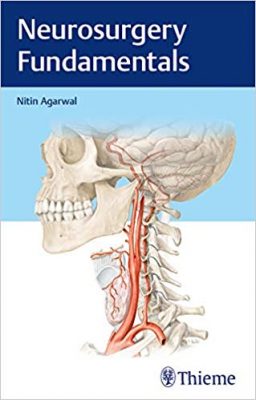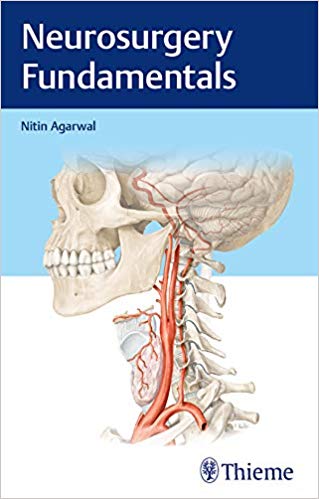 Editor: Nitin Agarwal, MD
Editor: Nitin Agarwal, MD
Publisher: Thieme – 412 pages + 302 illustrations
Book Review by: Nano Khilnani
This compact 5” x 8” handbook that fits in the coat pockets of neurosurgeons-in-training such as medical students, residents, fellows, as well as established and practicing specialists, provides a distilled form of the most essential and fundamental information required in neurosurgery practice.
This is a project developed and delivered in finished form by someone who is still a medical resident. It is a handy guide that is a ready-reference manual with a lot of information in brevity, as shown below just by its chapter list. That a young aspiring neurosurgeon like Dr. Nitin Agarwal can get 60 people to write or co-write the 20 chapters of this book is a firm indication of leadership and organizational ability, and points to a future of much accomplishment in the highly complex medical specialty of neurosurgery.
Sixty specialists in various aspects of neurology and neurosurgery, as well as other fields such as – critical care medicine, emergency and trauma medicine, immunology, oncology, radiology, and rehabilitation medicine – from all over the united States, except one from India, authored or coauthored the 20 chapters of this book. We list the chapters below to provide you an overview of the coverage of this handbook of just over 400 pages.
- Roadmap to a Career in Neurosurgery
- History of Neurological Surgery
- Neurological Examination
- Neuroanatomy
- Neuroradiology for the Neurosurgeon
- Operating Room
- Neurocritical Care
- Traumatic Brain Injury
- Spinal Trauma
- Spine
- Pain
- Cerebrovascular
- Neurosurgical Oncology
- Pediatric Neurosurgery
- Movement Disorders and Epilepsy
- Stereotactic Radiosurgery
- Neurological Infectious Diseases
- Interdisciplinary Care
- Socioeconomics in Neurosurgery
- Advice from the Masters
Access the additional media content online at www.MedOne.Thieme.com/9781626238220
This work is complete with lots of images in the form of charts, drawings (black and white and full-color) with captions, photographs, radiographs, schematics tables, and x-rays. Each chapter also provides at the end, a list of large numbers of references for further study.
Textbooks on neurosurgery or any aspects thereof that we have come about and reviewed in this space have usually been of larger formats such as 9” x 12” in page size and typically contain twice as many pages. Projects like those by other editors do not require a lot of creativity, in our opinion.
It is choosing which aspects of a medical specialty to include in a handbook tailored to a specific audience, that requires problem assessment and creative thinking to address those problems and provide solutions. This book is an example of the latter.
The Foreword writer Dr. Michael Lawton agrees. He states: “I know from my own experience that brevity is essential to be relevant to medical students and residents, and this handbook distills the basics of history, neurological examination, anatomy, radiology, and the operating room.”
Editor:
Nitin Agarwal MD is a Neurosurgery Resident and Enfolded Spine Surgery Fellow at the Department of Neurological Surgery at the University of Pittsburgh Medical Center in Pittsburgh, Pennsylvania.







